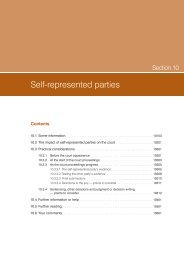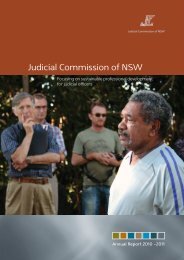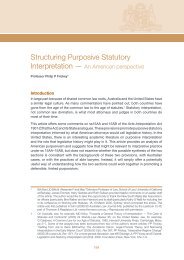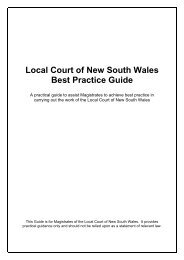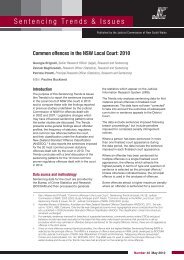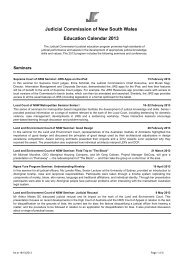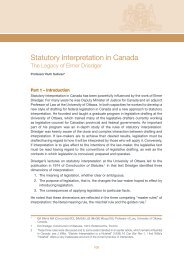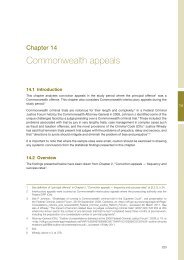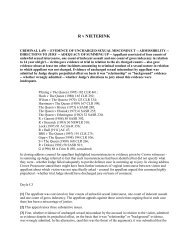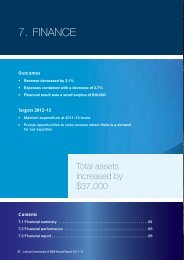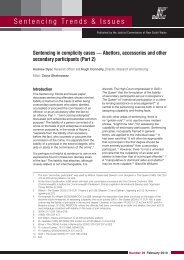Contents and summary - Judicial Commission of New South Wales
Contents and summary - Judicial Commission of New South Wales
Contents and summary - Judicial Commission of New South Wales
Create successful ePaper yourself
Turn your PDF publications into a flip-book with our unique Google optimized e-Paper software.
Summary <strong>of</strong> findings<br />
Almost two-thirds <strong>of</strong> robberies involved threats <strong>of</strong> violence (63.3%) as opposed to actual<br />
violence (36.7%). Actual violence was more likely to occur in robberies where there<br />
were multiple <strong>of</strong>fenders (43.5% compared with 18.5% <strong>of</strong> lone <strong>of</strong>fenders) or by younger<br />
<strong>of</strong>fenders (median age = 21 years compared with 23 years for robberies involving threatened<br />
violence).<br />
Subjective circumstances <strong>of</strong> the <strong>of</strong>fender<br />
Most <strong>of</strong>fenders (89.8%) were male <strong>and</strong> were aged from 14 to 58 years with a median <strong>of</strong><br />
22 years. Female robbers were in a narrower age group, from 18 to 36 years with a median <strong>of</strong><br />
22.5 years.<br />
The vast majority <strong>of</strong> <strong>of</strong>fenders (83.5%) had a criminal record. Just over a quarter <strong>of</strong> <strong>of</strong>fenders<br />
(27.6%) had priors for a robbery <strong>of</strong>fence under ss 94–98 <strong>and</strong> over half (56.0%) had priors for<br />
<strong>of</strong>fences other than robbery. Less than half <strong>of</strong> the <strong>of</strong>fenders (44.9%) had previously served a<br />
term <strong>of</strong> imprisonment imposed in an adult court. Around one-fifth <strong>of</strong> <strong>of</strong>fenders (19.0%) had<br />
previously served a term <strong>of</strong> imprisonment for a robbery <strong>of</strong>fence under ss 94–98.<br />
Most <strong>of</strong>fenders (61.6%) were on unconditional liberty at the time <strong>of</strong> committing the <strong>of</strong>fence.<br />
Fifty-four <strong>of</strong>fenders (15.3%) were on parole; 54 <strong>of</strong>fenders (15.3%) were on a bond, probation,<br />
community service order or on a Drug Court program; 3 <strong>of</strong>fenders (0.9%) were serving a<br />
term <strong>of</strong> periodic detention; <strong>and</strong> 21 <strong>of</strong>fenders (6.0%) were on bail. Another 3 <strong>of</strong>fenders (0.9%)<br />
were escapees at the time <strong>of</strong> committing the <strong>of</strong>fence.<br />
The vast majority <strong>of</strong> <strong>of</strong>fenders (83.5%) had a history <strong>of</strong> drug <strong>and</strong>/or alcohol use/abuse. Eight<br />
in 10 <strong>of</strong>fenders (79.6%) had a history <strong>of</strong> drug use/abuse <strong>and</strong> almost one-third <strong>of</strong> <strong>of</strong>fenders<br />
(32.7%) a history <strong>of</strong> alcohol use/abuse. Three-quarters <strong>of</strong> <strong>of</strong>fenders (75.4%) were addicted<br />
to alcohol <strong>and</strong>/or drugs at the time <strong>of</strong> the <strong>of</strong>fence. Seven in 10 <strong>of</strong>fenders (69.5%) had an<br />
addiction to drugs <strong>and</strong> 13.3% were addicted to alcohol. Three in 10 <strong>of</strong>fenders (30.4%)<br />
were under the influence <strong>of</strong> drugs (22.4%) or alcohol (12.5%) at the time <strong>of</strong> committing the<br />
<strong>of</strong>fence.<br />
Issues relating to the <strong>of</strong>fender’s mental health were raised in a third <strong>of</strong> cases (33.0%).<br />
Sentencing<br />
The majority <strong>of</strong> <strong>of</strong>fenders (85.2%) sentenced for a robbery <strong>of</strong>fence under s 97 received a<br />
full-time custodial sentence. These sentences ranged from 12 months to 15 years, with a<br />
median term <strong>of</strong> sentence <strong>of</strong> 4 years. The median sentence is at the lower limit <strong>of</strong> the Henry<br />
range <strong>of</strong> 4–5 years. Almost all cases attracted a finding <strong>of</strong> special circumstances (94.0%).<br />
A finding <strong>of</strong> exceptional circumstances resulted in 14.8% <strong>of</strong> <strong>of</strong>fenders receiving a noncustodial<br />
sentence.<br />
Apart from the need for a lengthy period <strong>of</strong> supervision in the community after release<br />
from prison, the main factors which resulted in a finding <strong>of</strong> either special or exceptional<br />
circumstances were good prospects <strong>of</strong> rehabilitation, young age <strong>and</strong> lack <strong>of</strong> or insignificant<br />
criminal record.<br />
xxi




